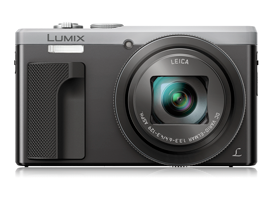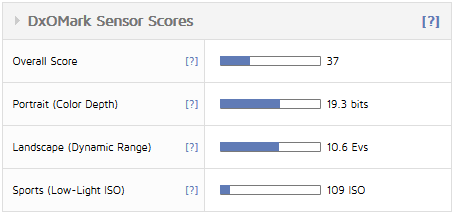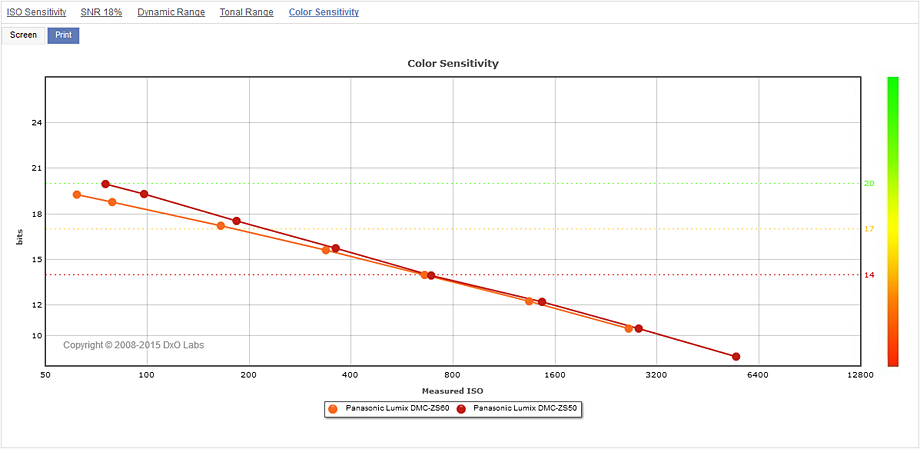Lumix ZS60 highlights
- EVF and LCD touchscreen
- 4K video
- 30x optical zoom (24-720mm equivalent)
- Good dynamic range of around 10EV up to ISO 200
- Good color around 17 bits up to ISO 200
Lumix ZS60 drawbacks
- Signal-to-noise ratio below 24 dB from ISO 800
- Low dynamic range and color from ISO 800
Overall image quality
At base ISO 80, the Lumix ZS60 is capable of some very good image quality with nice color of 19.3 bits and dynamic range of 10.6 EV. The small 1/2.3”-type sensor copes well considering its high 18.1Mp resolution, achieving a Sports low-light ISO score of 109 ISO. Although an overall score of 37 points is lower than we see on many cameras featuring a physically larger sensor, it’s more comparable with compacts and bridge cameras featuring the 1/2.3”-type sensor, whose overall scores are often in the 30s and 40s.
Image quality compared
Travel enthusiasts looking to capture more detailed scenes will welcome the increase in resolution over its predecessor, the 12.1Mp Lumix ZS50. The extra pixels on the same-sized sensor has had a slightly detrimental effect on overall image quality, however, with the ZS60 achieving slightly lower scores for all sensor metrics. It’s certainly not a huge difference, particularly considering that resolution has increased by a massive 50%; and despite slightly better results at base ISO on the ZS50, we can essentially say they offer the same overall image quality, with the best results achieved at the lower ISO sensitivities.
Image quality: Low-light ISO
You can see from the Lumix ZS60 signal-to-noise (SNR) ratios that the relatively small 1/2.3”-type sensor doesn’t offer outstanding low-light ISO performance over 38 dB at any ISO sensitivity. That said, considering the big jump in resolution up to 18.1Mp compared to 12Mp on the ZS50, the ZS60 copes remarkably well, essentially offering the same SNR with much higher resolution. The best results remain at the lower ISO sensitivities, however, and shooting at sensitivities at ISO 800 or above, you will notice a heavy buildup of noise, with a poor SNR below 20dB at ISO 1600 to ISO 3200. Taking into consideration the ZS60’s equivalent 24-720mm zoom lens with f/3.3-6.3 maximum aperture, if you’re looking to shoot at the long end of the zoom range, where the lens reduces the amount of light it can transmit to the sensor, you will achieve much better results in bright light conditions using lower ISO sensitivities. Panasonic’s Optical Image Stabilisation (O.I.S.) will help in certain situations, such as in landscape or architectural shots, for example, where the camera can use a slower shutter speed instead of increasing the ISO sensitivity.
Image quality: Landscape and Portrait
Landscape and Portrait scores hold up slightly better as ISO sensitivity is increased, with good color sensitivity over 17 bits and excellent dynamic range of around 10 EV up to ISO 200. Respectable dynamic range over 8 EV is possible up to manufacturer ISO 800, too, but color drops to a rather washed-out 14 bits. The higher levels of noise at ISO 800 can of course be smoothed a little in post-production, and in small-sized prints or electronic use online, the noise won’t be too concerning, but the lack of color saturation at the higher ISOs may not do your vacation pictures justice.
Conclusion
A travel zoom is an extremely convenient compact for day trips or longer vacations, packing an incredibly versatile optical zoom for both wide-angle and super-telephoto shots in a camera you can slip in your pocket. Updated with a new 18.1Mp chip, Panasonic’s latest Lumix ZS60 travel zoom packs plenty of resolution for richly detailed shots, 4K video capture for travel movie enthusiasts, and the ability to grab 8Mp stills from the video footage. The high-resolution built-in EVF will help composition if you’re struggling to use the LCD touchscreen in bright glare, and Panasonic’s hybrid O.I.S. image stabilization system will also help keep the ISO low in certain situations.
Despite boosting the resolution by 50% to 18.1Mp, Panasonic has managed to maintain a very similar level of image quality compared to its predecessor, the ZS50. You will achieve the best results using ISO sensitivities up to ISO 200, where color and ISO performance remain strong; and although good dynamic range is possible up to around ISO 800, weaker color and heavier noise reduce the overall image quality at these higher sensitivities.
Also consider
There’s a big range of alternative travel zoom compact cameras with 30x optical zooms a similar to that of the Lumix ZS60 and ZS50:
- 18.2Mp Sony WX500 for $398
- 18.2Mp Sony HX90V for $448
- 18.2Mp Sony HX80 for $368
- 20.3Mp Canon SX710 HS for $299
Specifications
- 18.1MP 1/2.3″ LIVE MOS Sensor
- Venus engine image processor
- 24-720mm (35mm equivalent) 30x zoom lens
- 1.16m-dot EVF
- 3.0″ 1.04m-dot LCD touchscreen
- 4K video (3840 x 2160) at 30p
- 5-axis hybrid O.I.S.
- ISO 6400, shooting up to 40 fps
- 4K photo modes and post-focus












DXOMARK encourages its readers to share comments on the articles. To read or post comments, Disqus cookies are required. Change your Cookies Preferences and read more about our Comment Policy.